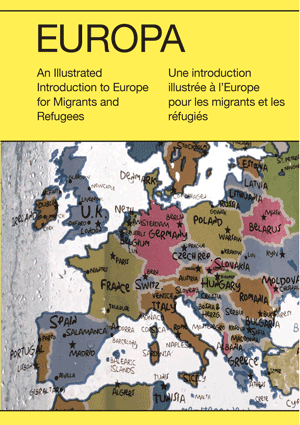

About
[NOT FOR SALE]
This book was initiated by a group of photographers and journalists who have been covering both the refugee crisis in Europe and the many contexts across the Middle East, Asia, and Africa that gave rise to these migrations. Harnessing the collective energy, skills and resources of its contributors, EUROPA is a collaborative and independent book, the first of its kind. Alia conceived of and edited its written content. It is intended for practical use by migrants and refugees, and as an educational tool to inform, engage, and facilitate community exchange.
The text is meant for a general readership and is written in four languages: Arabic, Farsi, English, and French. It aims to introduce newcomers to the motivations behind the creation of the European Union, how it developed, its current ethos, and the relevant debates that will determine its future.
Print copies have been distributed for free throughout Europe. Free e-versions or a full PDF can be found on the downloads page.
EUROPA is published by Al-Liquindoi
in partnership with the Arab Fund for Arts and Culture (AFAC).
Photo © 2015 Peter van Agtmael/Magnum Photo Refugees waving goodbye as they take a ferry from Kos to Athens
Synopsis
This book was initiated by a group of photographers and journalists who have been covering both the refugee crisis in Europe and the many contexts across the Middle East, Asia, and Africa that gave rise to these migrations. With front row seats to the challenges being faced by these newly arrived people, we were struck by the utility of information that a book like this could provide.
The text is meant for a general readership and is written in four languages: Arabic, Farsi, English, and French. It aims to introduce newcomers to the motivations behind the creation of the European Union, how it developed, its current ethos, and the relevant debates that will determine its future.
A note on vocabulary: “Refugee” and “migrant” are not interchangeable terms. Refugees are people who are fleeing armed conflict or persecution. Because it is too dangerous for them to return home, they need refuge elsewhere. Migrants are people who choose to move not because they face direct threats of persecution or death but mainly because they want to improve their lives for work, education, family reunion, or other reasons. If migrants choose to return home, they will continue to receive the protection of their government. How receiving countries treat refugees and migrants differs according to international and national laws.
Because the information provided here might be of service to both groups, we address all newcomers.
Few people we met as they desperately journeyed to the European Union knew that it arose from the devastation wrought by two world wars, that some of the member states were once bitter enemies, or that refugees have for decades crossed European borders in the aftermath of those and other wars.
While many arriving in Europe are unaware of this relatable history, many Europeans seem to have forgotten it. After all, the physical reality of Europe today barely hints at a past that arguably resembles the present in countries such as Syria, Iraq, and Afghanistan.
Thus with migration and conflict a part of Europe’s very fabric and an integral factor in the founding of the EU and the shaping of its populations, we selected these experiences as the lenses through which we would introduce contemporary Europe to these newcomers, as well as remind Europeans of their own past.
In addition to sharing this tailored narrative of Europe, this book features treasures from the archives of the international photography collective Magnum and first-person testimonies. Readers and viewers will be introduced to many of the different people who make up Europe today — from citizens to residents to immigrants to old and new refugees — in their own words, telling their stories of displacement, war, solidarity, and reconciliation.
Our idea was that in a shared experience, refugees and Europeans might see themselves in each other.
Finally, in the spirit of a travel guide, the last section of this book offers the reader useful information about the major destination countries (Germany, Italy, Austria, France, Sweden), including their different political systems, geography, demographics, traditions and major holidays, as well as typical foods and drinks, some books and films of interest, and lists of major government and nongovernmental organizations that provide information and service to migrants and refugees.
While this book does not pretend to be an exhaustive guide to the European Union, we have worked with and are very grateful to a team of refugees, immigrants, historians, policy experts, and social workers to try to provide the most relevant information possible.
For more information and to join the conversation, visit
Download
The first five thousand copies have already been distributed for free in Europe to refugees and the centers that work with them.
A full PDF in all languages can be or single language e-book versions are available for download below.
© 2017 Alia Malek
design and hosting by noumenon designs